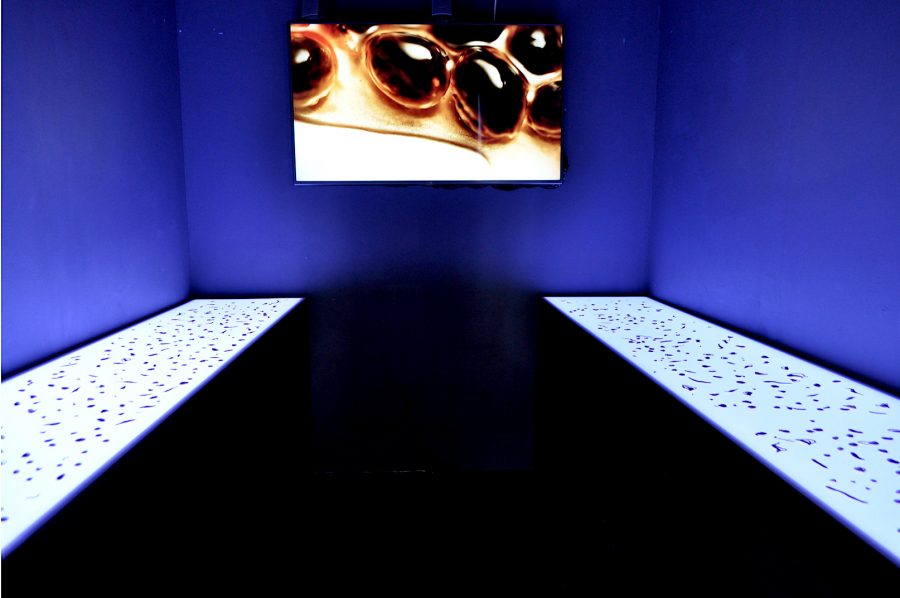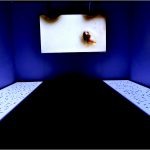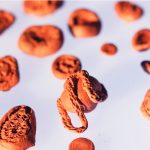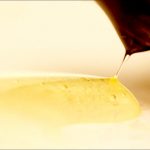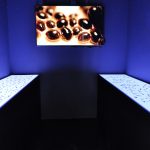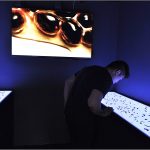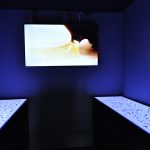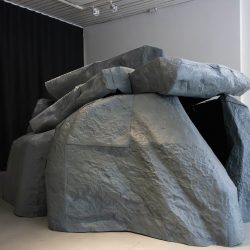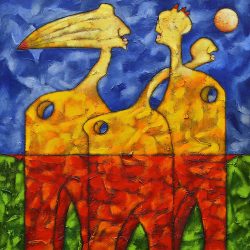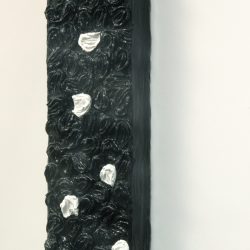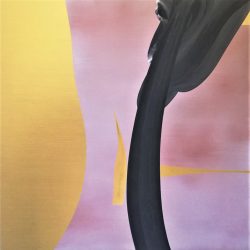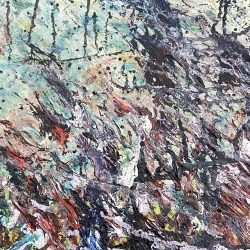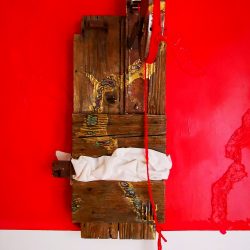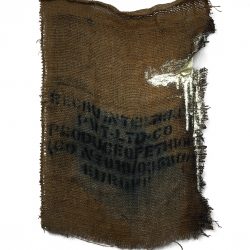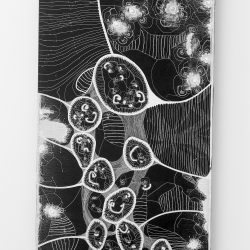work
Let me live longer
| category | Installation |
| subject | Abstract |
| tags | |
| base | 200 cm |
| height | 300 cm |
| depth | 400 cm |
| year | 2015 |
Papaya is known for having long-lived properties, thanks to its nutritional values. I am fascinated by how food affects our body and mind, in the triviality of everyday life - think, for example, of when we feel great satisfaction in eating a specific food because we know it will benefit us. Since 2015, deforestations in the Peruvian Amazon have been linked to the cultivation of papaya; this sad fact has increased my interest in developing the installation. In the installation, the video 'Let me live longer' is positioned at the end of the corridor created between the two lightboxes: the screen looks like an arrival point, almost an altar. While the images in the video 'Let me live longer' seem to want to seduce the viewer, showing papaya seeds flow in honey as if they were precious stones in a golden and divine river stream, the clear sound, coming from a working human stomach, creates a contrast with those pleasant and relaxing images: as if to remind us that, perhaps, the intimacy of our bodies that paw in the search for physical and mental pleasure hides a greater responsibility. In fact, papaya is one of those tropical fruits that travel thousands of kilometres to reach Europe, increasing CO2 emissions, to satisfy our visceral and aesthetic desires and our hopes of living longer. The following is the English translation of the article written by Xanthe Horner, on Cass Art, on 'Let me live longer' : De Nichilo’s work investigates the interchange between the micro and the macro, utilising the elements of sound, video and sculpture in an installation which presents a unique experience of the qualitative over quantitative scientific knowledge of our internal systems. Over mirrored speakers the distinct sound of a churning stomach can be heard. Within the darkened room the glow from the parallel lightboxes illuminates intricately moulded terracotta sculptures which hover across the stark surface akin to cells inside the body. The boundary between organic and synthetic is challenged by De Nichilo, whose practice is an exploration of releasing the body’s sensation from established scientific fact; the singularity of an individual’s experience of their body over the certainty of observable phenomena.
The video serves as a central focus within the installation, a provocative and visually stunning piece in which the artist has used rich foods such as honey, papaya seeds and olives in a visceral display which stirs desire both on a guttural and visual register. The seeds pass through the honey in a way akin to osmosis, the honey as a delicious, porous membrane, offering itself both as case study and indulgence. The stomach’s churning within the installation gives an intimate quality to the work, which places the viewer inside De Nichilo’s stomach, the noise with its own hypnotic rhythm which combined with the visually saturated video, lulls the viewer into a receptive state in registering their own body’s responses. De Nichilo has previously worked with the idea of the laboratory and the treadmill, the two light boxes serving as analogous to the clear, white space of the testing lab, whilst the horizontality calls to the mind the notion of a treadmill, of movement within a fixed space. De Nichilo is alerting the viewer to the fact of the constant change and movement taking place within the body at each moment, whilst the staticity of the terracotta sculptures allows viewers to imagine these changes on the cellular level in the artist’s physicalization and reimagining of that which can only be viewed through a microscopic lens.
The work of Michela De Nichilo offers a contemporary perspective on the body in an age where we are probing deeper into an understanding of physical phenomena on a molecular level. De Nichilo’s work asks questions of how this molecular understanding of the human body shapes an individual’s conscious experience, and what it means to explore the subjective within inner space. " Full article https://www.cassart.co.uk/blog/student-spotlight-goldsmiths.htm
Materials used: White Perspex, speakers, HD Video, LED light, MDF
The video serves as a central focus within the installation, a provocative and visually stunning piece in which the artist has used rich foods such as honey, papaya seeds and olives in a visceral display which stirs desire both on a guttural and visual register. The seeds pass through the honey in a way akin to osmosis, the honey as a delicious, porous membrane, offering itself both as case study and indulgence. The stomach’s churning within the installation gives an intimate quality to the work, which places the viewer inside De Nichilo’s stomach, the noise with its own hypnotic rhythm which combined with the visually saturated video, lulls the viewer into a receptive state in registering their own body’s responses. De Nichilo has previously worked with the idea of the laboratory and the treadmill, the two light boxes serving as analogous to the clear, white space of the testing lab, whilst the horizontality calls to the mind the notion of a treadmill, of movement within a fixed space. De Nichilo is alerting the viewer to the fact of the constant change and movement taking place within the body at each moment, whilst the staticity of the terracotta sculptures allows viewers to imagine these changes on the cellular level in the artist’s physicalization and reimagining of that which can only be viewed through a microscopic lens.
The work of Michela De Nichilo offers a contemporary perspective on the body in an age where we are probing deeper into an understanding of physical phenomena on a molecular level. De Nichilo’s work asks questions of how this molecular understanding of the human body shapes an individual’s conscious experience, and what it means to explore the subjective within inner space. " Full article https://www.cassart.co.uk/blog/student-spotlight-goldsmiths.htm
Materials used: White Perspex, speakers, HD Video, LED light, MDF



